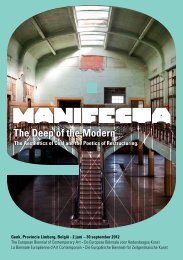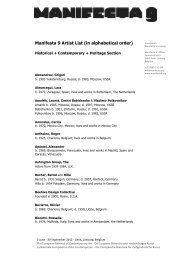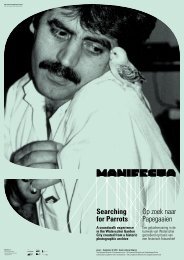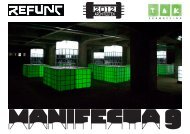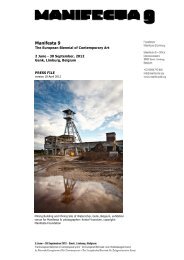informatie - Manifesta
informatie - Manifesta
informatie - Manifesta
You also want an ePaper? Increase the reach of your titles
YUMPU automatically turns print PDFs into web optimized ePapers that Google loves.
16 Waterschei, Genk, Limburg (Belgium), June–September 2012 Waterschei, Genk, Limburg (Belgium), June–September 2012<br />
17<br />
<strong>Manifesta</strong> 9: A Political Exhibition?<br />
A Conversation with Curator Cuauhtémoc<br />
Medina and Co-Curator Katerina Gregos<br />
What characterizes <strong>Manifesta</strong> as<br />
compared with other important<br />
biennials?<br />
Katerina Gregos: <strong>Manifesta</strong>, from<br />
its inception, has distinguished itself<br />
for experimenting with new curatorial<br />
models, often of a collaborative nature,<br />
and for addressing the changing geopolitical<br />
and socio-economic situation in<br />
Europe, as well as globally. It has also,<br />
in the past, played an important role<br />
in showcasing the work of promising<br />
young and emerging artists, many of<br />
whom have subsequently had significant<br />
international careers.<br />
Cuauhtémoc Medina: This is a<br />
<strong>Manifesta</strong> 9 Co-Curator<br />
Katerina Gregos<br />
Photo: Kristof Vrancken<br />
Katerina Gregos (Griekenland) is kunsthistoricus,<br />
curator en auteur en woont in Brussel. Ze was onder<br />
meer curator van het Deense paviljoen op de 54ste<br />
Biënnale van Venetië (2011): ‘Speech Matters’,<br />
een internationale groepstentoonstelling over<br />
vrijheid van meningsuiting en ‘Leaps of Faith: An<br />
International Arts Project for the Green Line and the<br />
City of Nicosia’, Cyprus (2005), de eerste internationale<br />
tentoonstelling over hedendaagse kunst die<br />
plaatsvond in beide delen van het eiland. Naast<br />
<strong>Manifesta</strong> 9 werkt ze momenteel aan ‘Newtopia: de<br />
staat van de mensenrechten’, een tentoonstelling<br />
voor de stad Mechelen, België (september 2012).<br />
In het verleden was ze artistiek directeur bij Argos,<br />
centrum voor kunst en media in Brussel en directeur<br />
van de Deste Foundation, centrum voor hedendaagse<br />
kunst in Athene, als mede curator van tal van grote<br />
internationale tentoonstellingen.<br />
Katerina Gregos (Greece) is an art historian, curator,<br />
lecturer and writer based in Brussels, Belgium.<br />
Amongst other projects she curated the Danish<br />
Pavilion at the 54th Venice Biennale (2011): Speech<br />
Matters, an international group exhibition on freedom<br />
of speech, Leaps of Faith: An International Arts<br />
Project for the Green Line and the City of Nicosia,<br />
Cyprus (2005), the first international contemporary<br />
art exhibition to take place on both sides. Next to<br />
<strong>Manifesta</strong> 9 she has Newtopia: The State of Human<br />
Rights, an exhibition for the City of Mechelen,<br />
Belgium, coming up (September 2012). Previously,<br />
she served as artistic director of Argos - Centre for<br />
Art & Media, Brussels, and director of the Deste<br />
Foundation, Centre for Contemporary Art, Athens, as<br />
well as curator of numerous international large-scale<br />
exhibitions.<br />
migratory biennial, one that changes of<br />
city or region every two years. In that<br />
sense, it symbolizes the way biennials institute<br />
a temporary cultural center, which,<br />
unlike the past, also migrates through a<br />
wide geography. In arriving at a new setting<br />
each time, <strong>Manifesta</strong> implicitly demands<br />
you to conjoin in a single project<br />
the need to address the specificity of a<br />
place’s history, the quest for a significant<br />
perspective on contemporary culture at<br />
large on an international scale and a contribution<br />
to the thinking of biennials as<br />
such. In that sense, <strong>Manifesta</strong> is a kind of<br />
symbol of the challenges and difficulties<br />
behind making biennials today…<br />
And what characterizes <strong>Manifesta</strong> 9<br />
in Genk?<br />
Gregos: This particular edition of<br />
<strong>Manifesta</strong> ise quite unique. First of all, it<br />
will not only focus on contemporary art<br />
and young artists but also have an art<br />
historical dimension. The exhibition will<br />
be divided into three parts: one featuring<br />
a historical exhibition (on the history of<br />
representation and aesthetic responses<br />
to the coal age, c. 1800–1960), a contemporary<br />
section with contributions from<br />
forty contemporary artists, and a heritage<br />
section. We are very lucky to have distinguished<br />
art historian and scholar Dawn<br />
Ades as part of the curatorial team and<br />
Dawn is of course bringing her enormous<br />
expertise into the historical section,<br />
something that is a first for <strong>Manifesta</strong>.<br />
Medina: We want to produce a synergy<br />
of those three components, and therefore<br />
establish a complex dialogue with Genk,<br />
in terms of its history and the heritage<br />
of its economic past, but also providing<br />
a diverse, rich and multilayered cultural<br />
provision, specially tailored to interact<br />
with both the local and international<br />
audience.<br />
Apart from this surprising decision<br />
to include a historical and a heritage<br />
section in a contemporary art biennial,<br />
what is the specific approach of<br />
<strong>Manifesta</strong> 9?<br />
Gregos: <strong>Manifesta</strong> 9 also addresses and<br />
counteracts the recent expanding and inflationary<br />
biennial model (more artists…<br />
more venues… more cities—often at the<br />
expense of the art & artists themselves)<br />
by being reduced in terms of the size<br />
and number of participating artists; it<br />
also takes place in a single venue only<br />
(the spectacular 1924 industrial building<br />
of the former Waterschei coal mine in<br />
Genk, region of Limburg, Belgium) and is<br />
thus a very tightly curated, focused and<br />
concentrated show.<br />
Medina: Thematically speaking, the<br />
contemporary component of the exhibition<br />
questions why is it that contemporary<br />
art is addressing the continuity of the<br />
Industrial system today at a global scale.<br />
It takes its cue from the way Genk has<br />
been created by different epochs of industrial<br />
transformation, to review the ways<br />
culture emerges from similar processes.<br />
To what extent is <strong>Manifesta</strong> 9 a<br />
political exhibition?<br />
Medina: The overall project of <strong>Manifesta</strong> 9<br />
has in fact a political intention, which is<br />
contrary to both: the outdated category<br />
and ironically counterproductive category<br />
of “political art” and the recent tendency<br />
of artistic events to delegate on artists,<br />
working in site-specific or communitybased<br />
projects, the task of having social<br />
importance by means of practices that<br />
appear as modalities of “direct action.”<br />
We assume that culture and art operate<br />
through a number of mediations, in<br />
creating and transforming the “common<br />
sense” that, indeed, in that way, has a<br />
significant political effect.<br />
Why did you decide to include historical<br />
artworks?<br />
Medina: The main purpose of the<br />
exhibition structure is to explore the<br />
extent to which an exhibition as a cultural<br />
initiative, and as a whole, can approach<br />
society’s assumptions and sensibilities<br />
in relation to the historical conditions<br />
caused by the changes in the modes of<br />
production around the world. Rather than<br />
delegating to artists the aim of having<br />
a social effect, we want to have the<br />
exhibition as a cultural machine to play a<br />
role in transforming the viewers’ ways of<br />
thinking and the mores of the locality.<br />
Did Genk inspire your decision to<br />
divide the biennial into three very<br />
different sections?<br />
Medina: We started by observing the<br />
divided responses that the coal mining<br />
heritage brings up today in regions such<br />
as Limburg: the gap between the energy<br />
of the former miners’ memory practices<br />
and the difficulty of incorporating that<br />
past into the challenges and dilemmas<br />
of the present. Such a dichotomy is<br />
experienced within a wider perspective<br />
in terms of a conflict between a nostalgia<br />
and a fear of the past, which in effect<br />
defines many of the ideological and political<br />
affiliations in Europe.<br />
So what to your mind could the effect<br />
of <strong>Manifesta</strong> 9 be on the visitor?<br />
Medina: We want to use the exhibition<br />
format of the biennial as an opportunity<br />
to challenge such reactions, and<br />
to provide a context to the work of the<br />
contemporary artists who are addressing<br />
the predicaments of the past and present<br />
of different industrial eras. We hope that<br />
it is by way of the mediations of culture<br />
that artistic practice will have a role in<br />
challenging and transforming political hegemonies,<br />
which also stands clear from<br />
a common dichotomy in the so-called art<br />
world: the deceptive fashion of invoking<br />
a vague idea of the “political-poetic” to<br />
once again define political significance<br />
as a matter of a sterile thematic or the<br />
impulse to deny the political significance<br />
of culture in favor of activism per se, even<br />
when this is devoid of a larger context.<br />
How important is the location for this<br />
edition of <strong>Manifesta</strong>?<br />
Gregos: Genk and indeed the building<br />
are crucial to the exhibition. Genk<br />
is one of the most important industrial<br />
cities in Flanders and was an important<br />
coal-making area (seven coal mines were<br />
located in and around the area) until the<br />
late 1980s and early 1990s, when the<br />
pits were shut down. <strong>Manifesta</strong> 9 will<br />
thus relate to the history and legacy of<br />
the coal-mining industry in the region,<br />
but also to the extended geography of<br />
the former mining region of Wallonia,<br />
Southern Belgium, as well as further<br />
North, to the Ruhrgebiet, all of which<br />
are areas that once represented Europe’s<br />
industrial powerhouse. For the contemporary<br />
part of the <strong>Manifesta</strong> exhibition we<br />
are focusing on artists who have worked<br />
with issues of industrial or post-industrial<br />
production, de-industrialization, economic<br />
re-structuring, transferring centers of<br />
production and shifting labor conditions,<br />
and material production in general.<br />
Can you tell us more about the<br />
relationship between the historical<br />
coalmining era and today?<br />
Gregos: In short, we are looking into<br />
the legacy of coal and its manifestations<br />
today in terms of work and production, in<br />
a world of industrial and post-industrial<br />
capitalism. This part is not related to<br />
coal and the coalmining industry per se,<br />
but to questions related to the changing<br />
patterns of production, industrialism<br />
and post-industrialism, economic<br />
restructuring, and the new economic and<br />
labor conditions that have come with<br />
them. As a site where industry once<br />
was and economic restructuring has<br />
subsequently taken place in the wake of<br />
the pit closures, the region’s history has<br />
prompted us to consider all of these important<br />
questions that do not only affect<br />
economy, labor and social relations but<br />
also crucial environmental questions.<br />
Could you explain the historical<br />
ingredient of the show?<br />
Medina: As we have three very different<br />
initiatives that, however, intend to<br />
converge in the same place and at the<br />
same moment, the question of “theme”<br />
does not govern the project in the same<br />
way as occurs with other biennials that<br />
are organized as a single mega-exhibition<br />
of global contemporary art. Each one<br />
of the three components (heritage, art<br />
historical and contemporary) has specific<br />
curatorial goals. The art historical show,<br />
The Age of Coal, consists in close to ten<br />
different theme-based historical essays,<br />
each of them covering a moment or issue<br />
(from the aesthetics of pollution to the<br />
figuration of the Carboniferous era) in<br />
which the effects and challenges posed<br />
by the dominance of coal as industrial<br />
civilization’s fossil fuel produced artistic<br />
thought and work.<br />
And what’s about the presence of<br />
heritage objects?<br />
Medina: The heritage section, which we<br />
named 17 Tons, does on purpose seek to<br />
open the eyes to the complexity, energy<br />
and variety of the cultural production<br />
based on memory practices about coal<br />
mining in the region and beyond. Its<br />
theme is: where does the potential of<br />
heritage as cultural production lie?<br />
As <strong>Manifesta</strong> is a contemporary art<br />
biennial, do give us a last thought<br />
about the contemporary art component<br />
in <strong>Manifesta</strong> 9.<br />
Medina: The contemporary section has a<br />
very broad-ranging concept—to explore<br />
the ways contemporary art reflects on<br />
the changes in the productive system—<br />
that does not produce sections in the<br />
installation and concept of the show, but<br />
intends to produce a resonance and an<br />
intellectual and sensible interaction with<br />
the other parts of the project. We don’t<br />
want the single theme to operate both as<br />
a wide and reductive formula, to invoke a<br />
complex meditation within the relationship<br />
between art and production, across<br />
several disciplines and periods.<br />
<strong>Manifesta</strong> 9: Een politieke<br />
tentoonstelling?<br />
Een gesprek met curator Cuauhtémoc<br />
Medina en co-curator Katerina Gregos<br />
Wat is er speciaal aan <strong>Manifesta</strong> in vergelijking<br />
met andere grote biënnales?<br />
Katerina Gregos: <strong>Manifesta</strong> heeft zich vanaf het<br />
begin onderscheiden van andere tentoonstellingen<br />
doordat er geëxperimenteerd werd met nieuwe<br />
rollen voor de curator – die vaak een medewerker<br />
werd van de kunstenaar – en doordat ook de<br />
geopolitieke en socio-economische situatie in Europa<br />
en de wereld ter sprake kwam. In het verleden heeft<br />
<strong>Manifesta</strong> bovendien een belangrijke rol gespeeld bij<br />
het onder de aandacht brengen van veelbelovende<br />
jonge kunstenaars, van wie er velen nadien begonnen<br />
zijn aan een internationale carrière.<br />
Cuauhtémoc Medina: Deze biënnale heeft geen<br />
vaste stek – om de twee jaar vindt ze plaats in een<br />
andere stad of een andere regio. In die zin symboliseert<br />
<strong>Manifesta</strong> hoe biënnales een tijdelijk cultureel<br />
centrum vormen dat door een uitgestrekt gebied<br />
migreert – wat vroeger niet het geval was. Door<br />
telkens van decor te wisselen, vraagt <strong>Manifesta</strong> expliciet<br />
aan de bezoeker om mee te gaan in een uniek<br />
project dat uiteenlopende zaken aan de orde stelt: de<br />
specificiteit van de geschiedenis van een locatie, de<br />
zoektocht naar een betekenisvolle kijk op hedendaagse<br />
cultuur – op internationale schaal – in het<br />
algemeen en daarnaast is er ook nog een bijdrage<br />
aan het denken over biënnales als dusdanig. In die<br />
zin is <strong>Manifesta</strong> een symbool voor de uitdagingen<br />
en moeilijkheden van het maken van een biënnale<br />
vandaag de dag.<br />
En wat is er speciaal aan <strong>Manifesta</strong> 9 in Genk?<br />
Gregos: Deze editie van <strong>Manifesta</strong> wordt echt<br />
uniek. In de eerste plaats richt ze zich niet alleen op<br />
hedendaagse kunst en jonge kunstenaars, maar er is<br />
ook een historische dimensie. De tentoonstelling is<br />
verdeeld in drie delen. Er is een historische tentoonstelling<br />
(over de geschiedenis van de representatie<br />
van en esthetische respons op het steenkooltijdperk,<br />
van 1800–1960). Daarnaast is er een hedendaags<br />
gedeelte met bijdragen van negenendertig hedendaagse<br />
kunstenaars. En tenslotte is er een deel<br />
met erfgoed. We hebben heel erg veel geluk dat<br />
kunsthistoricus en wetenschapper Dawn Ades deel<br />
uitmaakt van het team van curatoren. Dawn brengt<br />
haar gigantische expertise mee voor het historisch<br />
gedeelte en dat is natuurlijk van het grootste belang<br />
voor <strong>Manifesta</strong>.<br />
Medina: We willen een synergie bereiken tussen de<br />
drie componenten en daarom gaan we een complexe<br />
dialoog aan met Genk wat betreft de geschiedenis<br />
van de stad en het erfgoed van het economisch verleden.<br />
Maar we zorgen ook voor een rijke gelaagdheid<br />
wat betreft de culturele dimensie zodat een<br />
wisselwerking kan ontstaan met het plaatselijke en<br />
internationale publiek.<br />
Een historisch en erfgoedgedeelte op een hedendaagse<br />
kunstbiënnale is een verrassende<br />
beslissing. Hoe ziet de specifieke aanpak van<br />
<strong>Manifesta</strong> 9 er verder uit?<br />
Gregos: <strong>Manifesta</strong> 9 reageert ook tegen het huidige<br />
expansieve en inflatoire model voor biënnales met<br />
steeds meer kunstenaars, meer locaties, meer<br />
steden... Dat gaat vaak ten koste van de kunst en de<br />
kunstenaars zelf. <strong>Manifesta</strong> 9 is beperkt wat betreft<br />
de omvang en het aantal deelnemende kunstenaars.<br />
Er is ook maar één locatie, namelijk het spectaculaire<br />
gebouw uit 1924 van de voormalige mijn van<br />
Waterschei in Genk. Op die manier krijgen we een<br />
bijzonder geconcentreerde tentoonstelling, waarbij<br />
de curatoren een sterke focus hebben.<br />
Medina: Thematisch werpt het hedendaagse luik<br />
van de tentoonstelling de vraag op waarom de<br />
hedendaagse kunst de continuïteit van het hedendaagse<br />
industriële systeem aan de orde stelt, iets<br />
wat we in de hele wereld zien. Ons model is Genk,<br />
een stad die het resultaat is van een industriële<br />
transformatie gedurende verschillende periodes. Via<br />
Genk onderzoeken we hoe cultuur ontstaat vanuit<br />
vergelijkbare processen.<br />
In welke mate is <strong>Manifesta</strong> 9 een politieke<br />
tentoonstelling?<br />
Medina: Het globale project heeft inderdaad een<br />
politieke dimensie die verwijst naar een dubbele<br />
contradictie. Enerzijds refereren we aan de<br />
achterhaalde categorie van de ‘politieke kunst’ – die<br />
ironisch genoeg ook een averechts effect heeft.<br />
Anderzijds is er de recente tendens waarbij kunstenaars<br />
bij artistieke evenementen site-specifieke werken<br />
moeten maken, of werken die te maken hebben<br />
met de lokale gemeenschap, en daarbij moeten die<br />
werken ook nog eens een maatschappelijk belang<br />
hebben door te fungeren als een soort direct action.<br />
Wij gaan uit van de veronderstelling dat cultuur en<br />
kunst werken via een soort overpeinzen van de dingen<br />
en het transformeren van het ‘gezond verstand’.<br />
En dat heeft inderdaad een belangrijk politiek effect.<br />
Waarom wilden jullie ook historische kunstwerken<br />
in de tentoonstelling opnemen?<br />
Medina: Het belangrijkste doel van de tentoonstelling<br />
is om uit te zoeken in welke mate een tentoonstelling<br />
als cultureel initiatief, als geheel, een<br />
benadering kan aanreiken voor wat in de hedendaagse<br />
maatschappij leeft, voor wat de gevoeligheden<br />
zijn van de maatschappij met betrekking tot de<br />
historische omstandigheden die te maken hebben<br />
met veranderingen in de productiewijze in de hele<br />
wereld. In plaats van te eisen dat de kunstenaars<br />
een maatschappelijk effect nastreven, willen we<br />
dat de tentoonstelling fungeert als een culturele<br />
machine die de manier waarop het publiek denkt kan<br />
veranderen.<br />
Vonden jullie inspiratie in Genk zelf voor de<br />
beslissing om de biënnale in drie verschillende<br />
luiken te splitsen?<br />
Medina: We zijn vertrokken van de observatie dat<br />
het erfgoed van de steenkoolindustrie uiteenlopende<br />
reacties teweegbrengt in regio’s zoals Limburg. Er<br />
blijkt een kloof te zijn tussen enerzijds de energie<br />
van vroegere mijnwerkers en wat er in hun geheugen<br />
voortleeft en anderzijds de moeilijkheid om het<br />
verleden te incorporeren in de uitdagingen en de<br />
dilemma’s waarvoor het heden ons plaatst. We<br />
plaatsen die tweespalt in een grotere context: we<br />
zien het probleem als een conflict tussen nostalgie<br />
en angst voor het verleden – een probleem waaraan<br />
inderdaad veel ideologische en politieke facetten<br />
verbonden zijn binnen Europa.<br />
Wat voor effect kan <strong>Manifesta</strong> 9 dan volgens<br />
jullie hebben op de bezoeker?<br />
Medina: We willen het format van de biënnale<br />
gebruiken als een gelegenheid om reacties van het<br />
publiek uit te lokken en om het probleem aan de<br />
orde te stellen van dilemma’s van de vroegere en<br />
huidige industriële tijdperken. We hopen dat door<br />
reflectie over cultuur de kunst een rol kan spelen<br />
in het uitdagen en transformeren van politieke<br />
hegemonieën. Daarmee nemen we ook afstand van<br />
een wijdverbreide conflict in de zogenaamde kunstwereld:<br />
er is namelijk de bedrieglijke mode om een<br />
vaag idee te evoceren dat te maken zou hebben met<br />
het ‘politiek-poëtische’, om op die manier opnieuw<br />
wat politiek belangrijk is definiëren in termen van<br />
iets dat thematisch steriel is, of als een impuls om<br />
het politieke belang van een cultuur te ontkennen –<br />
alleen activisme als dusdanig zou dan politiek belang<br />
hebben, ook als dat activisme geen bredere context<br />
heeft.<br />
Hoe belangrijk is de locatie voor deze editie<br />
van <strong>Manifesta</strong>?<br />
Gregos: Genk en ook het gebouw zijn cruciaal voor<br />
deze tentoonstelling. Genk is een van de belangrijkste<br />
industriële steden in Vlaanderen en was ook<br />
belangrijk voor de steenkoolwinning. De zeven mijnen<br />
in de regio werden pas op het eind van de jaren<br />
tachtig/in het begin van de jaren negentig gesloten.<br />
<strong>Manifesta</strong> 9 verwijst daarom naar de geschiedenis<br />
en het erfgoed van de mijnindustrie in de regio, maar<br />
in de breedte ook naar de mijnindustrie in Wallonië<br />
en meer in het noorden naar de industrie in het<br />
Ruhrgebied – regio’s die alle ooit Europa’s industriële<br />
motor vormden. Voor de huidige editie van <strong>Manifesta</strong><br />
richten we ons vooral op kunstenaars die reeds<br />
gewerkt hebben rond thema’s als de industriële<br />
of postindustriële productie, de-industrialisatie,<br />
economische herstructurering, delokalisatie van de<br />
productie, veranderende werkomstandigheden of<br />
materiële productie in het algemeen.<br />
Kunt u ons iets meer vertellen over de relatie<br />
tussen het historische tijdperk van de steenkoolwinning<br />
en het heden?<br />
Gregos: We verkennen de erfenis van de steenkoolwinning<br />
en wat we daarvan vandaag terugvinden<br />
in termen van werk en productie in de wereld van<br />
het industriële en postindustriële kapitalisme. Dat<br />
heeft niet per se te maken met steenkool of de<br />
steenkoolindustrie, maar in elk geval met kwesties<br />
die te maken hebben met veranderende productiewijzen,<br />
met een geïndustrialiseerde economie,<br />
postindustrialisme en economische herstructureringen,<br />
en met de nieuwe economische en arbeidsomstandigheden<br />
die daarmee gepaard gaan. Als<br />
voormalige industriële site en als plaats waar in de<br />
nasleep van de mijnsluitingen grote economische<br />
herstructureringen hebben plaatsgevonden, heeft<br />
de geschiedenis van de regio ons geïnspireerd al<br />
die belangrijke kwesties aan de orde te stellen – dit<br />
zijn problemen die niet alleen te maken hebben met<br />
economie, werk en maatschappelijke verhoudingen,<br />
maar ook met het milieu.<br />
Kunt u wat meer uitleg geven over de historische<br />
component van de tentoonstelling?<br />
Medina: Omdat we te maken hebben met drie<br />
verschillende initiatieven – die weliswaar samen<br />
plaatsgrijpen op dezelfde plaats en tijd – speelt de<br />
kwestie van het ‘thema’ hier niet dezelfde rol als<br />
bij andere biënnales die georganiseerd worden als<br />
één megatentoonstelling van hedendaagse kunst uit<br />
de hele wereld. Met elk van de drie componenten<br />
(erfgoed, historische kunst en hedendaagse kunst)<br />
beoogt de curator een specifiek doel. De kunsthistorische<br />
tentoonstelling, Het tijdperk van de steenkool,<br />
omvat tien verschillende historische essays over een<br />
bepaald thema. Elk van die essays behandelt een<br />
moment of een onderwerp – van de esthetiek van de<br />
vervuiling tot de representatie van het carboon – die<br />
te maken hebben met de problemen en de gevolgen<br />
van het overwegend gebruik van de steenkool als<br />
fossiele brandstof en hoe dat uitdrukking vindt in de<br />
ideeënwereld en het werk van de kunstenaar.<br />
Hoe zit het met objecten die te maken hebben<br />
met het erfgoed?<br />
Medina: Het luik over het erfgoed kreeg de titel 17<br />
Ton mee. Onze bedoeling is de ogen te openen van<br />
het publiek voor de complexiteit, de energie en de<br />
variatie van de culturele productie die verankerd is<br />
in het geheugen van de mensen die een rol gespeeld<br />
hebben bij de steenkoolwinning in de regio en<br />
daarbuiten. Het thema is: wat is het potentieel van<br />
het erfgoed als cultuurproduct.<br />
<strong>Manifesta</strong> is een biënnale van hedendaagse<br />
kunst. Kunnen jullie ons ook nog iets vertellen<br />
over het hedendaagse luik van deze<br />
<strong>Manifesta</strong> 9?<br />
Medina: Het hedendaagse luik is gebaseerd op<br />
een erg ruim concept – we willen verkennen hoe de<br />
hedendaagse kunst nadenkt over de veranderingen<br />
in het productiesysteem. We proberen niet om de<br />
kunst in hokjes in te delen als installatiekunst of<br />
conceptuele kunst, maar we willen een weerklank<br />
vinden, of komen tot een intellectuele en gevoelsmatige<br />
interactie met andere delen van het project. We<br />
willen niet dat één thema fungeert als een formule<br />
die tegelijk de horizon verbreedt en inperkt. We willen<br />
dat mensen in brede zin nadenken over de relatie<br />
tussen kunst en productie, en daarbij de verschillende<br />
disciplines en periodes overstijgen.




